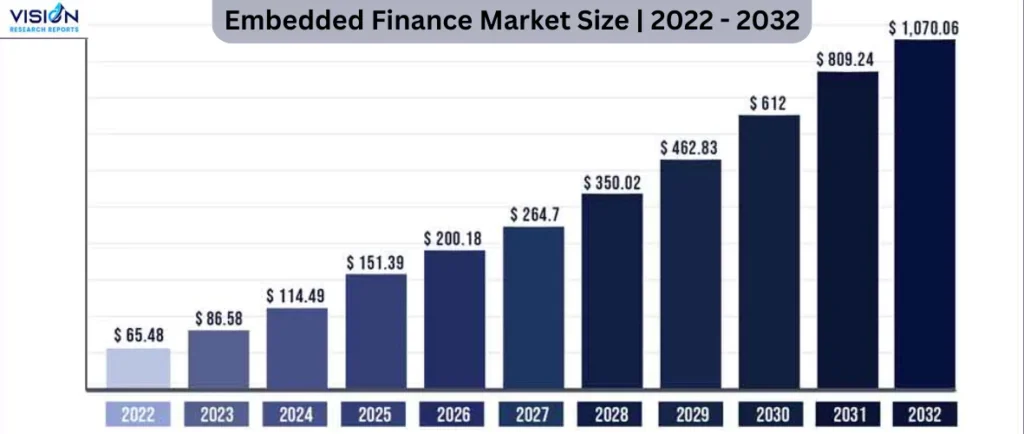Embedded finance is a growing area of fintech that seamlessly integrates financial services and tools into digital experiences and physical products. By establishing APIs and partnerships, companies across industries can offer contextual banking services to improve customer experiences.
Embedded finance blurs the lines between traditional banking and wider commercial environments through these digital integrations. In this article, we will explore what embedded finance is, how it works, and explore some prominent examples of how financial products are embedded into various experiences. We will also discuss the benefits and opportunities embedded finance creates, as well as the potential risks and challenges that come with this new model.
What is Embedded Finance?
At its core, embedded finance refers to financial products, utilities, and transactions being incorporated within the user flows of non-financial companies and platforms. By establishing direct connections to banking infrastructure via APIs, these organizations can provide value-added services without being classified as regulated financial institutions.
Some examples of financial activities that can be embedded include payments, lending, transactions, money transfers, account management tools, investment capabilities, and insurance products. The goal is to match banking functionality with relevant contexts through these partnerships, increasing customer convenience and loyalty.

Embedded finance aims to develop financial services that are integrated at the point of need within existing customer journeys. For instance, a marketplace may include billing payment features or a ride-hailing app could offer integrated payroll services for drivers.
By seamlessly merging banking abilities with non-finance software, embedded finance enhances these platforms’ value propositions while broadening opportunities for financial innovation beyond traditional industry borders. Importantly, it introduces banking capabilities to entirely new customer demographics as well.
How Embedded Finance Works

At a technical level, embedded finance relies on APIs or application programming interfaces to establish connections between financial and non-financial systems. APIs act as an intermediary, allowing the secure exchange of data and transactions in real-time.
Financial institutions develop APIs compatible with various platforms. These APIs provide interfaces for functions like account registration, payment processing, lending decisions, and more.
Non-financial companies then integrate select APIs relevant to their businesses and customers. This allows embedding banking-like tools contextualized to their specific applications and workflows. Users interact with financial features from within existing products without leaving the environments they know.
Meanwhile, banks and fintechs expand distribution by powering new partner companies’ services. Partners monetize through commissions on financial transactions while banks gain valuable data insights and access to new potential customers. Profitability improves for all parties through expanded reach in this digital ecosystem.
Examples of Embedded Finance
To better understand embedded finance in practice, it helps to examine some prominent examples where financial services have been contextualized within various user experiences:
- eCommerce Payments: Major online retailers embed digital payment processing like debit/credit cards, buy now pay later into shopping carts and checkout flows.
- Gig Work Payrolls: Ridesharing and delivery platforms integrate payroll deposits, expense reimbursements, and other cash flow tools for independent workers.
- B2B Invoicing: Accounting software inserts billing features, and collection capabilities directly into invoicing and AR/AP workflows for businesses.
- Real Estate: iBuying services provide pre-qualified financing options upfront during home search and bidding processes.
- Travel: Airlines and hotels offer foreign exchange services, and travel insurance at the point of booking reservations and payments.
- Social Platforms: Networks embed peer-to-peer payment options directly within conversations between friends, families, and followers.
By thoughtfully incorporating financial services where they matter to users, embedded models enhance loyalty while delivering new value on both sides of all these partnerships. This convergence will only continue accelerating.
Benefits of Embedded Finance
As the above examples demonstrate, embedded finance introduces a diverse mix of benefits that have spurred its rising adoption across industries:
Seamless User Experience: Merging financial tools into existing flows streamlines previously disjointed experiences, improving user convenience.
- Actionable Context: Placing banking at the point of need based on each integration provides insightful usage context compared to generic transactions.
- New Distribution Channels: Partnerships open embedded finance providers’ access to large captive audiences beyond existing customer bases.
- Strengthened Loyalty: Convenient embedded services build stronger relationships between platforms and engage users through added perceived value.
- Multi-sided Network Effects: Integrating financial network effects within non-financial platforms enhances utility across ecosystems for all participants.
- Personalization Opportunities: Contextual behavioral data grants abilities to tailor experiences and products customized for individuals.
- Operational Synergies: Joint innovation between financial and non-finance platforms drives new product ideas that improve internal efficiencies as well.
Overall, these assorted benefits position embedded finance models to transform how customers interact with financial services for the better through seamless digital convergence across industries. Understanding context-specific needs fosters innovation.
Potential Risks of Embedded Finance
While promising gains exist, embedded finance also surfaces new types of risks that require prudent management:
- Regulatory Compliance: Ensuring all partners meet licensing and consumer protection standards across differing regulations presents challenges.
- Security & Privacy: Safely exchanging and storing sensitive financial information within foreign systems necessitates strong cybersecurity governance.
- Interoperability Issues: Complex integration requires cooperation between independent infrastructure which introduces compatibility and data exchange risks.
- Conduct Risks: Subtle product steering or overly incentivized cross-selling carries reputational hazards if not properly governed.
- Dispute Handling: Disagreements spanning financial and non-financial facets need clear resolution frameworks in place.
- Dependence Risks: Over-reliance on a few strategic partnerships introduces a point of failure exposure across the broader embedded ecosystem.
Proper risk management along with cooperation between regulators, embedded finance providers, and integration partners remain paramount for building public trust and long-term sustainability in this maturing space. Growing pains will be addressed via experience.
Future Opportunities

Given its early stage, embedded finance represents a rapidly evolving frontier with ample room for further innovation and integration across industries in the coming years. Some promising opportunity areas include:
- Healthcare: Integrating medical payments, insurance tools, and claims directly within telehealth platforms and provider workflows.
- Education: Embedding tuition payment plans, student loan options, and savings tools within learning management systems.
- Real Estate: Incorporating smart contract-based property transactions, document eSigning, and escrow functions directly into MLS listings networks.
- Government: Modernizing tax filing, benefits disbursement, and identity verification through embedded finance within citizen-facing portals.
- Travel & Entertainment: Offering seamless event/experience ticket financing, deposits, subscriptions, and loyalty programs.
Embedded finance positioned financial services for the digital age by contextualizing them wherever value emerges. Its growing scope projects steadily blurring traditional borders, optimizing experiences through this convergence. Strategic partnerships will shape user-centric innovation across industries.
Conclusion
Embedded finance represents a game-changing shift in how consumers interact with and access financial tools. By thoughtfully integrating open banking services into everyday digital experiences, partnerships uniquely improve utility for users, platforms, and banks simultaneously. Its benefits have transformed distribution while personalizing once-generic products.
While ongoing governance will optimize security and fairness, embedded models promise to reinvent industries by revolutionizing how we manage money within applications underpinning modern life. Continued convergence will only optimize experiences further, blurring borders between functions as technology streamlines interconnected systems behind the scenes.













